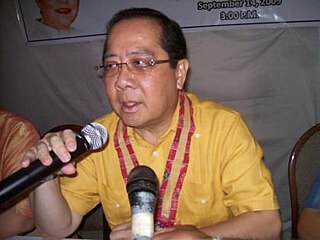
Antipolo, officially the City of Antipolo, is a 1st class component city and capital of the province of Rizal, Philippines. According to the 2020 census, it has a population of 887,399 people. It is the most populous city in the Calabarzon region, and the seventh most-populous city in the Philippines.
Urban Bank, also known by its initials UBI, was a middle-sized bank in the Philippines. The bank, along with its two subsidiaries, declared a voluntary bank holiday for failing to meet withdrawals and was consequently closed by the Bangko Sentral ng Pilipinas and put under the mandatory receivership of the Philippine Deposit Insurance Corporation on April 26, 2000. It merged with Export and Industry Bank in 2001.

The Upsilon Sigma Phi (ΥΣΦ) is the oldest Greek-letter organization and fraternity in Asia. Founded in 1918, it is also the oldest student organization in continuous existence in the University of the Philippines. It has two chapters—a single chapter for the UP Diliman and UP Manila campuses, and another for UP Los Baños. Membership remains exclusive to UP students, and is by invitation only.

Tau Gamma Phi (ΤΓΦ), also known as Triskelions’ Grand Fraternity, is a fraternity established in the Philippines. Its members call themselves Triskelions.

Ronaldo Villanueva Puno, also known as Ronnie Puno, is a campaign manager and strategist in Philippine politics. He supported the presidential bids of eventual winners Fidel V. Ramos, Joseph Estrada, and Gloria Macapagal Arroyo. Puno was also responsible for the campaign of Vice President and UNA presidential candidate Jejomar Binay for the 2016 election.
2000 in the Philippines details events of note that happened in the Philippines in the year 2000.

Robert Vincent Jude "Dodot" Bautista Jaworski Jr. is a Filipino politician, businessman, and former basketball player who is the vice mayor of Pasig. He previously served as a member of House of Representatives representing the Lone District of Pasig from 2004 to 2007.

Hinulugang Taktak Protected Landscape, also known as Hinulugan Taktak, is a protected area located in Rizal, Philippines. Initially assigned as a recreation area, the waterfall area has been designated as a national park by virtue of Republic Act No. 6964 in 1990. Ten years later, it became a protected landscape in accordance to Proclamation No. 412. It is being managed by the Department of Environment and Natural Resources and the Rizal Provincial Government. As of 2003 and 2004, Hinulugang Taktak is the second most popular national park in the Philippines in terms of number of visitors.
Glenn Ang Chong is a Filipino politician. He was elected as a Member of the House of Representatives, representing the Lone District of Biliran. He held the position for three years before he lost his re-election bid to Rogelio J. Espina, twin brother of Gerardo Espina Sr.
1999 in the Philippines details events of note that happened in the Philippines in the year 1999.

Florin "Pilo" Ternal Hilbay is a Filipino lawyer who served as the Solicitor General of the Philippines from 2014 to 2016, serving the Philippine agent in the international case, Philippines v. China, which nullified all historical claims of China in the West Philippine Sea. He ranked first place in the 1999 Philippine Bar Examination.

On September 20, 2018, a landslide caused by heavy rainfall and quarrying operations by Apo Land and Quarry Corporations (ALQC) in Naga, Cebu, Philippines, killed 78 people. Five others are missing. This is the second deadly landslide to occur in the country in five days; the first occurred in Itogon, Benguet, on September 15, triggered by Typhoon Mangkhut (Ompong), leaving at least 35 dead.

Bukidnon's 4th congressional district is one of the four congressional districts of the Philippines in the province of Bukidnon. It has been represented in the House of Representatives of the Philippines since 2013. The district consists of the province's most populous city, Valencia, and the municipalities of Kalilangan and Pangantucan. It is currently represented in the 19th Congress by Laarni Roque of the Nacionalista Party (NP), who has represented the district since its creation.

Globe Asiatique Realty Holdings Corp (GARHC), simply known as Globe Asiatique, is a Philippine real estate corporation.
The 2002 Puerto Princesa mayoral recall election was held on September 24, 2002, in the city of Puerto Princesa, Palawan, Philippines. Former mayor Edward Hagedorn defeated incumbent Victorino Dennis Socrates in the recall election.

The Bagong Henerasyon Party-List, also known as BH Party List is a political organization which has party-list representation in the House of Representatives of the Philippines.

Severe Tropical Storm Nalgae, known in the Philippines as Severe Tropical Storm Paeng, was a very large and deadly tropical cyclone that wreaked havoc across the Philippines and later impacted Hong Kong and Macau. The 22nd named tropical storm of the 2022 Pacific typhoon season, Nalgae originated from an invest located east of the Philippines on October 26. The disturbance, initially designated as 93W, was eventually upgraded the following day to a tropical depression by the Joint Typhoon Warning Center (JTWC) and re-designated as 26W. The Japan Meteorological Agency (JMA) however, had already considered the disturbance as a tropical depression a day prior to JTWC's; the Philippine Atmospheric, Geophysical and Astronomical Services Administration (PAGASA) also followed the JMA's lead and gave it the name Paeng. That same day, it was upgraded again by the JMA to tropical storm status, thus gaining the name Nalgae. The next day, the PAGASA and the JTWC upgraded Nalgae to a severe tropical storm status on October 28. Nalgae would eventually made its first landfall in Virac, Catanduanes, which was quickly followed by another landfall thirty minutes later. It then traversed the Bicol Region and emerged into Ragay Gulf, eventually making another landfall. Defying initial forecasts, Nalgae then moved southwestward and struck Mogpog. Afterwards, the storm moved northwestward into the Sibuyan Sea and struck Sariaya. Then it would move through many regions throughout the evening of October 29. Nalgae emerged over the West Philippine Sea the next day and weakened below tropical storm status. The storm would later re-intensify into a severe tropical storm a few hours later, and eventually exited the Philippine Area of Responsibility a day later. Upon its exit from Philippine jurisdiction, Nalgae then intensified into a Category 1-equivalent typhoon on JTWC; however, the JMA maintained its severe tropical storm classification for the system. It then approached the Pearl River Delta. At around 04:50 CST on November 3, 2022, Nalgae made its final landfall at Xiangzhou District as a tropical depression.











